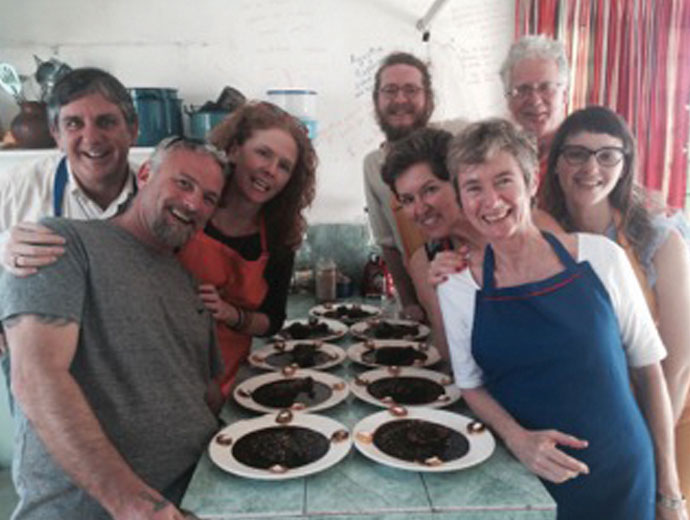
OAXACA? Never heard of it! I had thoroughly explored the Yucatan in my youth from Isla Mujeres to the ruins in Tulum and Chichen Itza. But Oaxaca? First I needed to get oriented geographically. Oaxaca city is in the state of Oaxaca in the southern region of Mexico. I used the opportunity during the brief 2 hour flight from Houston directly to Oaxaca to quickly study notes and recommendations from a few friends that had visited there. Gayden’s cousin, Penny Morrill, a published and renowned expert on pre-Colonial Mexican art history, provided us with a wealth of information regarding the indigenous cultures, ruins, museums and abundance of churches in Oaxaca. I also did my own research on the markets and where to purchase local Zapotec and Mixta folk art such as red, green and black pottery, woolen rugs from Teotitlan de Valle and the whimsical and meticulously hand painted carved copal wood figures also known as “alebrijes.”
What I was amazed to discover was that Oaxaca is internationally renowned as one of the food and “foodie” capitals of Mexico. It was truly fate that I should land in Oaxaca. Ah yes, I could now fulfill one of my culinary goals at the top of my cooking bucket list; learn to master the fine art of preparing the complex mole negro. I had arrived at the source. From the streets, to the market, to the high-end cafes, Oaxaca’s colorful and varied gastronomic offerings range from street pozole to modern takes on traditional Oaxacan cuisine at upscale restaurants serving locally sourced innovative foods. Using simple indigenous ingredients such as corn, quesillo (Oaxacan string cheese), black beans, chiles, chocolate, grains, locally-sourced meats and a smattering of vegetables to make tamales, tlayudas, tacos, (we loved the barbecued goat tacos), empanadas, moles and more, Oaxaca offers a variety of taste sensations that surprise and at times overload the senses. These savory foods are paired with the distinctive Oaxacan smoky flavored tequila, mescal, that is typically served with “sal con gusano”, salt with a dried extract of the Maguey worm.
Chapulines, or grasshoppers, are eaten as part of the regular diet in Oaxaca. They are abundant and are sold on the street, at markets, and prepared fried in olive oil with peppers and garlic in restaurants. Yes, I tasted them. Took me back to the dos when my kids were younger and they ate chocolate covered ants and crickets at the zoo. I am not sure if the chapulines have any nutritional value but they did add an interesting element of crunch to our tacos and quesadillas.
Back to the quest for the perfect mole. Oaxaca is known as the land of seven moles. Some of the mole types include Negro, Rojo, Coloradito, Amarillo, and Verde. Rice is usually included to help sop up every delicious drop. Oaxacan moles require a complex combination of up to 25-30 ingredients and long cooking times, and for this reason are traditionally served only for special occasions. I was determined to learn to make a mole negro while in Oaxaca so I signed up myself and my traveling companions for a 5 hour authentic Oaxaca cooking class, mescal included, in Esperanza and Augustin’s kitchen. We worked non stop for 6 hours, with several eating and drinking breaks in between, to prepare guacamole, salsa rojo and verde, white corn tortillas , squash blossom quesidallas and chicken tinga, typical Mexican street fare, and then the piece de resistance, mole negro. This is a recipe for cooking with friends….foodies and friends. Here it is, from Esperanza’s kitchen , and from my kitchen to you, Holy mole it’s Mole Negro and it is some darn good!

 This recipe is adapted from My Search for the Seventh Mole by Susana Trilling and from the Oaxacan Cooking classes by Esperanza
This recipe is adapted from My Search for the Seventh Mole by Susana Trilling and from the Oaxacan Cooking classes by Esperanza
Servings: 12
INGREDIENTS
| • 5 chile chilhuacle negro (1 ½ ounces) or substitute guajillos
• 5 chile guajillo (1 ounce) • 4chile pasilla mexicano (1 ounce) • 4chile ancho negro or mulato (2 ounces) • 2 chile chipotle meco (1/4 ounce) • 1medium white onion, quartered • 1/2small head of garlic, 6-8 cloves separated • 1 TBSP chopped ginger • 2heaping tablespoons almonds • 2tablespoons shelled and skinned raw peanuts and pecans • 1 inch Mexican cinnamon (canela) • 3 black peppercorns • 3 whole cloves • 3 pinches of saffron • 2 pinches of anise seeds • 2tablespoons oil • 1 1/2tablespoons raisins • 1slice slice of bread, preferably challah or an egg bread • 1small ripe plantain, cut into ½-inch slices (about 1 cup) • 1/2cup sesame seeds • 2 TBSP pumpkin seeds • 1/2pound (1 medium-large round or 4 to 5 plum)ripe tomatoes, cut into chunks • 1/4pound (2 to 3 medium) fresh tomatillos, husked, rinsed and cut into chunks • 1sprig fresh thyme, or ¼ teaspoon dried • 1sprigMexican oregano or ½ teaspoon dried • 5generous cups light chicken stock • 2tablespoonslard or oil • 6ouncesMexican chocolate • Salt |
INSTRUCTIONS
Rinse the chiles quickly in running water, and remove all stems, veins and seeds. Reserve the seeds. Heat 2 quarts of water in a kettle. In a large griddle, comal or frying pan, toast the chiles over medium heat until black, but not burnt, about 10 minutes. Place the chiles in a large bowl and cover with the hot water to soak for 30 minutes. When the chiles are soft, remove the chiles from the soaking water with tongs, placing small batches in a blender with ½ cup of the chile soaking water (or more if needed) to blend smooth. Pass the chile puree through a food mill or strainer to remove the skins.
In the same dry griddle, comal or frying pan, roast the onion and garlic over medium heat for 10 minutes. Set aside. Toast the almonds, peanuts, the cinnamon stick, peppercorns, ginger and cloves on the same pan for about 5 minutes. Remove from the pan.
Over the same heat, toast the chile seeds, taking care to blacken but not burn them, about 20 minutes. Try to do this outside or in a well-ventilated place because the seeds will give off very strong fumes. Remove from the heat and place in a bowl. Soak the blackened seeds in 1 cup of cold water for 10 minutes. Drain the seeds and cover them with more water. Let them soak another 15 minutes more, then strain them. Grind them in a blender for about 2 minutes with ½ cup of water. Strain them through a medium-mesh strainer. Add the blended chile seeds to the blended chile mixture.
Heat 3 tablespoons of oil in a medium skillet over medium heat. Add the raisins and fry them until they are plump, approximately 1 minute. Remove from pan. Fry the bread slices in the same oil until browned, about 5 minutes; remove from pan. Fry the plantain in the same oil until it is well-browned, approximately 10 minutes, and set aside.
In a separate frying pan, heat 2 tablespoons oil and fry the sesame seeds, stirring constantly over low heat, adding salt if they start jumping around too much. When the sesame seeds start to brown, about 5 minutes, add the pecans and pumpkin seeds and brown 2 minutes more. Remove all from the pan, let cool, and grind finely in a spice grinder or a powerful blender with ½ cup stock. The spice grinder takes a bit of time, but this is the only way to grind the seeds and nuts finely enough. The mixture should be very smooth.
Wipe out the frying pan and fry the tomatoes, tomatillos, thyme and oregano, anise and saffron, over medium to high heat, allowing the juices to almost evaporate, about 15 minutes. Blend well, using ½ cup stock if needed to blend and set aside.
In the blender, in small batches if necessary, place the nuts, bread, plantains, raisins, onion, garlic and spices. Blend well, adding about 1 cup chicken stock to make it smooth.
In a large cazuela or stock pot, heat 2 tablespoons of lard or oil until smoking and fry the chile paste over medium to low heat, stirring constantly so it will not burn, approximately 20 minutes. When it is “bubbling furiously,” add the tomato puree and fry until the liquid has evaporated, about 20 minutes. Add the ground ingredients, including the sesame seed paste, to the pot. Stir constantly with a wooden spoon until well incorporated, about 20 minutes. Add 1 cup chicken stock, stir well, and allow to cook 30 minutes, stirring occasionally.
Break up the chocolate and add to the pot, stirring until it is melted and incorporated into the mixture.
Toast the avocado leaves briefly over the flame if you have a gas range, or in a dry frying pan and add to the pot. Slowly add more stock to the sauce—it will keep thickening as it cooks. Continue to cook for at least 30 minutes, stirring occasionally so it doesn’t stick. Add stock as it thickens. The more time it has to cook the better. There should be no gritty texture (from the seeds), which will cook out over time. Add enough salt to bring out the flavors. If you can only taste the chiles, you need more salt. The mole should not be thick, just thick enough to coat the back of a spoon. Serve over cooked chicken pieces or sliced turkey breast with lots of rice or warm tortillas on the side to soak up the sauce.





